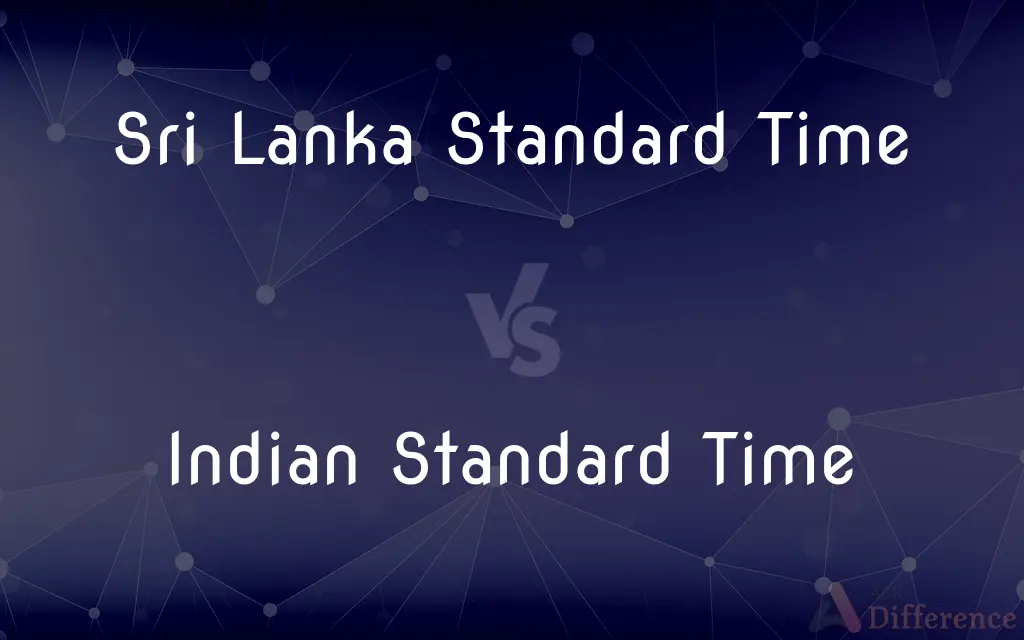Sri Lanka Standard Time vs. Indian Standard Time — What's the Difference?
By Maham Liaqat & Urooj Arif — Published on February 22, 2024
Sri Lanka Standard Time (SLST) and Indian Standard Time (IST) both operate at UTC+5:30, making them identical in terms of time offset but distinct in their geographical application.

Difference Between Sri Lanka Standard Time and Indian Standard Time
Table of Contents
ADVERTISEMENT
Key Differences
Sri Lanka Standard Time (SLST) and Indian Standard Time (IST) share the same offset from Coordinated Universal Time (UTC+5:30), indicating that the time displayed on clocks in both Sri Lanka and India is the same. However, the designation of the time zones serves to distinguish the national standard times of two separate countries. SLST is exclusively used in Sri Lanka, an island nation south of India, while IST is used across India, the seventh-largest country by land area.
Despite the shared time offset, the reasons behind adopting this uniform time are rooted in historical and geographical considerations. For India, IST was established to create a single unified time zone across its vast territory, simplifying governance, communication, and commerce. Sri Lanka, being a much smaller country, adopted SLST for similar reasons of national coherence, but its adoption of the same offset as IST reflects both geographical proximity and the practical benefits of aligning with the major regional economic partner.
Neither country observes daylight saving time, which means that SLST and IST remain consistent throughout the year, further simplifying timekeeping and international coordination between the two. This consistency aids in travel, business, and diplomatic relations, ensuring that time differences do not complicate schedules and communications.
The adoption of a unified time standard within each country, despite being at the same offset, underscores the importance of national identity and administrative convenience. It allows each country to maintain its own standard time while facilitating cross-border interactions without the need for time conversions.
In global dealings, recognizing the distinction between SLST and IST is crucial for clarity in international communication, scheduling, and legal documentation. It respects the sovereignty and distinct identities of Sri Lanka and India, despite the practical similarities in their timekeeping.
ADVERTISEMENT
Comparison Chart
Offset from UTC
UTC+5:30
UTC+5:30
Geographic Application
Sri Lanka
India
Daylight Saving Time
Not observed
Not observed
Purpose
Unifies Sri Lanka under a single time zone
Unifies India under a single time zone
Historical Reason
Reflects geographical and administrative simplicity
Aims for national coherence across diverse regions
International Significance
Facilitates regional coordination, especially with India
Important for international business and diplomacy
Adoption
Chosen to align closely with regional timekeeping norms
Established to simplify across a vast territory
Compare with Definitions
Sri Lanka Standard Time
The time zone for Sri Lanka, fixed at UTC+5:30.
Colombo, Sri Lanka, operates on SLST year-round.
Indian Standard Time
Symbolizes India's unified national identity.
IST represents India's cohesive approach to time, uniting diverse regions.
Sri Lanka Standard Time
Does not include daylight saving adjustments.
SLST remains constant, avoiding the confusion of daylight saving changes.
Indian Standard Time
The unified time zone across India, also at UTC+5:30.
New Delhi, Mumbai, and Kolkata all operate on IST.
Sri Lanka Standard Time
Ensures national unity in timekeeping.
All of Sri Lanka follows SLST for consistency in business and daily life.
Indian Standard Time
Eliminates the need for multiple time zones within the country.
IST was adopted to streamline timekeeping across India's vast expanse.
Sri Lanka Standard Time
Aligns Sri Lanka's standard time with India's, despite being separate countries.
SLST and IST share the same offset, simplifying travel between Sri Lanka and India.
Indian Standard Time
Constant throughout the year without daylight saving.
Businesses in India plan according to IST, without adjusting for daylight saving.
Sri Lanka Standard Time
Reflects Sri Lanka's commitment to regional synchronization.
Adopting SLST facilitates coordination with its larger neighbor, India.
Indian Standard Time
Aids in national and international scheduling.
IST simplifies setting up meetings with partners in different countries.
Common Curiosities
How does the shared time offset affect travel between Sri Lanka and India?
The shared time offset simplifies travel and scheduling between the two countries, eliminating the need for time conversions.
Are there any plans for either country to adopt daylight saving time?
As of the last update, neither Sri Lanka nor India observes daylight saving time, preferring to keep their time standard consistent year-round.
Can the shared time offset lead to confusion in international dealings?
While the shared offset simplifies regional coordination, international dealings require clear communication to distinguish between SLST and IST.
How do businesses benefit from the shared time offset between Sri Lanka and India?
Businesses benefit through simplified scheduling and reduced complexity in logistics and communications, enhancing bilateral trade and cooperation.
How do international companies operating in both Sri Lanka and India manage the shared time offset?
International companies leverage the shared time offset to streamline operations, scheduling, and project management across both countries, reducing administrative overhead and improving coordination.
Does the identical time offset affect digital communications and IT operations between Sri Lanka and India?
Yes, the identical time offset facilitates seamless digital communications and IT operations, allowing for real-time collaboration without the need for time conversion, thus enhancing efficiency in cross-border projects and services.
Are there historical reasons for Sri Lanka and India sharing the same time offset?
The shared time offset is more a matter of geographical proximity and practicality than historical reasons. Both countries independently decided on UTC+5:30 to best suit their national needs while benefiting from regional coherence.
How does the shared time offset between SLST and IST impact the tourism industry?
For tourists traveling between India and Sri Lanka, the shared time offset simplifies travel arrangements, flight schedules, and activity planning, making the travel experience more convenient and enjoyable.
Why do Sri Lanka and India use the same time offset?
Both countries use the same time offset (UTC+5:30) for geographical proximity and administrative convenience, despite being separate nations.
What role does the shared time offset play in education and academic collaborations between the two countries?
The shared time offset supports synchronized academic schedules, virtual classrooms, and collaborative research projects, making it easier for institutions in both countries to engage in joint educational initiatives.
How do media broadcasts and telecommunications handle the shared time offset?
Media broadcasts and telecommunications are scheduled according to the local time zone of the audience. The shared time offset ensures that live broadcasts, news, and communications are synchronized between Sri Lanka and India, enhancing the audience experience.
Is there any impact on cultural exchanges between Sri Lanka and India due to the identical time offset?
The identical time offset promotes cultural exchanges by facilitating synchronized telecasts of cultural programs, sports events, and joint initiatives, thus strengthening cultural ties and mutual understanding.
How do emergency services coordinate cross-border operations between Sri Lanka and India?
In cross-border emergencies, the shared time offset allows for immediate and synchronized response efforts, enabling efficient coordination of rescue operations, disaster management, and humanitarian aid.
What challenges might arise from the shared time offset for SLST and IST in terms of global trade?
While the shared time offset simplifies regional trade, global trade operations must still navigate time differences with partners in other time zones, requiring careful scheduling to accommodate business hours across the world.
How do SLST and IST affect the scheduling of international sports events hosted by Sri Lanka or India?
For international sports events, the shared time offset means that games hosted in either country can be broadcast live at convenient times for audiences in both nations, enhancing viewership and fan engagement across the region.
Share Your Discovery

Previous Comparison
Hulk vs. Wolverine
Next Comparison
SLST vs. ISTAuthor Spotlight
Written by
Maham LiaqatCo-written by
Urooj ArifUrooj is a skilled content writer at Ask Difference, known for her exceptional ability to simplify complex topics into engaging and informative content. With a passion for research and a flair for clear, concise writing, she consistently delivers articles that resonate with our diverse audience.














































